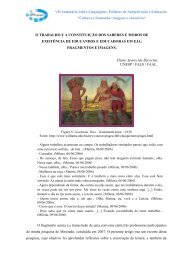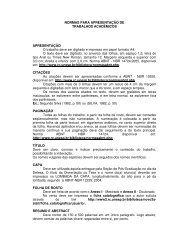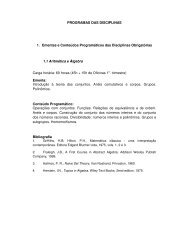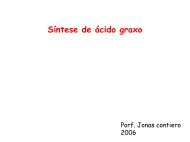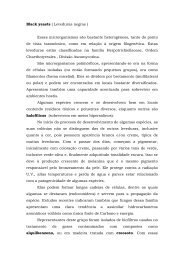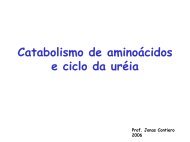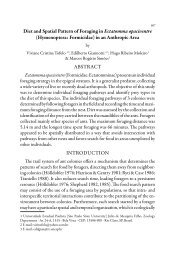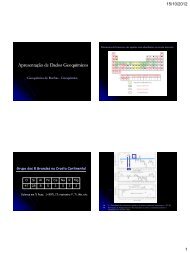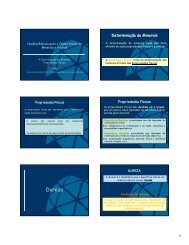Vol. 14 N° 1, 2013 - UNESP Rio Claro
Vol. 14 N° 1, 2013 - UNESP Rio Claro
Vol. 14 N° 1, 2013 - UNESP Rio Claro
Create successful ePaper yourself
Turn your PDF publications into a flip-book with our unique Google optimized e-Paper software.
The influence of the history of science in designing learning indicators:<br />
electromotive force in dc circuits<br />
La influencia de la historia de la ciencia en el diseño de indicadores de aprendizaje:<br />
fuerza electromotriz en circuitos cc<br />
Jenaro GuIsasola 1 , Isabel Garzón 2 , krIstIna zuza 1<br />
1<br />
Department of Applied Physics. Universidad del País Vaco UPV-EHU, Spain<br />
2<br />
Department of Physics. Universidad Pedagógica Nacional, Colombia , jenaro.guisasola@ehu.es<br />
Abstract<br />
In this paper we shall consider the history of science, within the concept of the teaching<br />
of the sciences, as a useful instrument for identifying where the problems lie in the<br />
construction of concepts and theories; indicating epistemological barriers that had<br />
to be overcome and the ideas that permitted advancement. From this point of view, we<br />
have developed a conceptual framework for the topic of the electromotive force. We<br />
have subsequently formulated learning indicators that indicate the different stages<br />
that must be worked through in a learning sequence, and that establish the major<br />
concepts and ways of reasoning that students should learn. We shall show that in the<br />
case of electromotive force knowledge of the historical difficulties and of the ideas<br />
that contributed to overcoming these difficulties furnished us with useful information<br />
for designing solidly based teaching sequences and learning objectives<br />
Key words: history of electricity, electromotive force in continuous current circuits,<br />
designing teaching sequences and learning indicators<br />
Resumen<br />
En este trabajo se considera la historia de la ciencia en el contexto de la enseñanza<br />
de la física como un instrumento para identificar problemas en la construcción<br />
de los conceptos y teorías. Así mismo, la historia puede indicar posibles barreras<br />
epistemológicas que debieron superarse y las ideas que permitieron avanzar. Desde<br />
este punto de vista, hemos definido el marco teórico para el concepto de fuerza<br />
electromotriz en el contexto de circuitos eléctricos. A continuación hemos definido<br />
los indicadores de aprendizaje que pueden guiar los diferentes pasos que deben<br />
trabajarse en una secuencia de aprendizaje y establecer los conceptos y formas de<br />
razonamiento más importantes. Se mostrará las evidencias epistemológicas que<br />
apoyan la secuencia de enseñanza del concepto de fuerza electromotriz.<br />
Palabras clave: historia de la electricidad, fuerza electromotriz en circuitos de<br />
corriente continua, diseño de secuencias de enseñanza e indicadores de aprendizaje<br />
INTRODUCTION<br />
The current consensus is that the comprehension of concepts and theories<br />
requires knowledge not only of the current state of understanding of a particular<br />
topic, but also of the way that knowledge was developed and refined, over<br />
time (Duschl 2000; Matthews 1994; McComas et al 2000; Rudge & Home<br />
2004; Wandersee 1992). The structure of science, the nature of the scientific<br />
method and the validation of scientists’ judgements, are some of the areas in<br />
which the history and philosophy of science can enrich the teaching of science.<br />
Scientific concepts and theories do not emerge miraculously, but rather are the<br />
result of an arduous problem-solving process and of the rigorous contrasting<br />
with initial hypotheses (Nerssesian 1995). Consequently, knowledge of the<br />
development of explicative ideas, which eventually resulted in the current<br />
scientific model, can bring important information when it comes to designing<br />
teaching sequences (Duschl 1994).<br />
There are many arguments defending the inclusion of the history of science<br />
in the curriculum and especially its integration in learning strategies (Clough<br />
& Olson 2004; Izquierdo & Aduriz-Bravo 2003; Seroglou et al 1998; Solomon<br />
2002), but very few studies have been published that explore this perspective<br />
in relation to the selection of knowledge that could aid the development of<br />
teaching sequences. In this paper, within the concept of the teaching of the<br />
sciences, we shall consider the History of Science as a useful instrument for<br />
identifying where problems lie in the construction of concepts and theories;<br />
indicating the epistemological barriers that had to be overcome and the<br />
ideas that permitted advancement. Building on this information, learning<br />
indicators can be elaborated that help in designing teaching sequences that<br />
will significantly improve the teaching and learning of concepts and theories.<br />
Nevertheless, in order for this information to be useful in the design of the<br />
didactic sequence it requires a historical and epistemological study carried<br />
out with ‘didactic intentionality’ and knowledge of the difficulties students<br />
have when trying to learn.<br />
We have chosen the concept of electromotive force as the field of study<br />
for our presentation. A number of inter-related reasons have resulted in the<br />
choice of this idea. Firstly, this notion is included in both secondary school<br />
programmes (age 16-18) and first year university courses in engineering and<br />
sciences. Secondly, it is a basic prerequisite for explaining the functioning of a<br />
direct current circuit. From a scientific viewpoint, and in the context of simple<br />
electrical circuits, electromotive force is a property that quantifies the energy<br />
delivered to the charge unit by the electrical generator or battery. Examples<br />
of emf sources are battery, which converts chemical energy into electrical<br />
energy. A source of emf does work on the charge passing through it, raising the<br />
potential energy of the charge. A series of ‘non-electrostatic electrical actions’<br />
take place in the battery, through which energy is delivered to the charge<br />
unit and this energy is quantified by means of the property ‘electromotive<br />
force’. Thus, in physics, the concept of electromotive force is defined in a<br />
very specific manner in relation to the concepts of charge, potential, electric<br />
field and current intensity; and is used to explain the behaviour of electrical<br />
generators in circuits.<br />
From the viewpoint of the epistemology of science, we cannot underestimate<br />
an analysis of the controversy that resulted from an electrodynamic<br />
interpretation of electrical circuits, that began with <strong>Vol</strong>ta’s explanation and<br />
that lasted through the first half of the 19 th century with contributions from<br />
Ohm and Kirchhoff. The concept of the electromotive force is relevant since<br />
it coincided with the historical period that produced the transition from<br />
electrostatics to electrokinetics, and the major repercussions this produced at<br />
the technological and research level during the first quarter of the 19 th century<br />
(Sutton 1981; Willians 1962; Wise 1990). One example of this technological<br />
innovation is the battery; the subject being so spectacular that one can now<br />
scarcely conceive a society without them; a few examples are: pacemakers,<br />
hearing aids, mobile telephony, a great number of home appliances.<br />
The paper we present here aims to answer the following research questions:<br />
a) Elaboration of a conceptual framework, based on the history and epistemology<br />
of science, that will permit us to answer questions such as: Which problem<br />
in the origin of the concept of electromotive force do we wish to teach our<br />
students?; What obstacles had to be overcome and which ideas contributed to<br />
overcoming these obstacles?; What difficulties do students have in learning<br />
the essential ideas that constitute the concept of electromotive force?<br />
b) Formulation of learning indicators for the concept of electromotive force,<br />
based on the preceding conceptual framework and that can be useful<br />
in designing a teaching sequence for this concept. What knowledge do<br />
students need to be able to understand the function of a battery in a simple<br />
direct current circuit? What problems would be suitable as a basis for the<br />
teaching?<br />
The principal difficulties generated during the history the development<br />
of the concept of electromotive force will be outlined first. Then we shall<br />
establish learning indicators for the concept of electromotive force that can<br />
be useful in designing a teaching sequence.<br />
THE TRANSITION FROM ELECTROSTATICS TO<br />
ELECTROKINETICS DURING THE FIRST HALF OF THE 19 TH<br />
CENTURY<br />
Between the end of the 18 th and the beginnings of the 19 th centuries, the work<br />
of scientists such as Coulomb, Lagrange and Poisson, among others, permitted<br />
the fixing of the mathematical fundaments of electrostatics, in a definitive<br />
manner, by defining properties utilising analytical calculus tools (Brown<br />
1969; Buchwald 1977; Fox 1990; Frankel 1977; Guerlac 1976; Sutton 1981).<br />
4 JOURNAL OF SCIENCE EDUCATION - Nº 1, <strong>Vol</strong>. <strong>14</strong>, pp. 4-8, <strong>2013</strong>, ISSN 0124-5481, www.accefyn.org.co/rec



